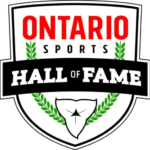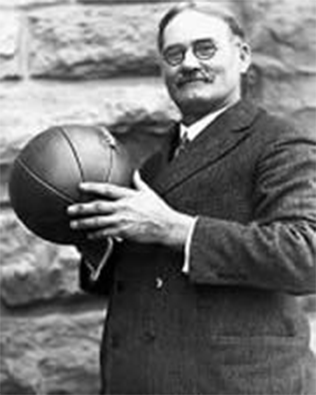James Naismith (November 6, 1861 – November 28, 1939) was a Canadian and naturalized American sports coach and innovator. Naismith invented the sport of basketball in 1891 and is often credited with introducing the first football helmet. Naismith wrote the original basketball rulebook, founded the University of Kansas basketball program, and lived to see basketball adopted as an Olympic demonstration sport in 1904 and as an official event in 1936. Naismith’s contributions to basketball have earned him several posthumous enshrinements, such as in the Canadian Basketball Hall of Fame, the Canadian Olympic Hall of Fame, the Canadian Sports Hall of Fame, the Ontario Sports Hall of Fame, the Ottawa Sports Hall of Fame, the McGill University Sports Hall of Fame, the Kansas State Sports Hall of Fame and the FIBA Hall of Fame. The Naismith Memorial Basketball Hall of Fame carries his name.
Springfield College: Invention of “Basket Ball”
At Springfield YMCA, Naismith struggled with a rowdy class which was confined to indoor games throughout the harsh New England winter and thus was perpetually short-tempered. Under orders from Dr. Luther Gulick, head of Springfield YMCA Physical Education, Naismith was given 14 days to create an indoor game that would provide an “athletic distraction”: Gulick demanded that it would not take up much room, could help its track athletes to keep in shape and explicitly emphasized to “make it fair for all players and not too rough”.
In his attempt to think up a new game, Naismith was guided by three main thoughts. Firstly, he analyzed the most popular games of those times (rugby, lacrosse, soccer, football, hockey and baseball); Naismith noticed the hazards of a small fast ball and concluded that the big soft soccer ball was safest. Secondly, he saw that most physical contact occurred while running with the ball, dribbling or hitting it, so he decided that passing was the only legal option. Finally, Naismith further reduced body contact by making the goal unguardable, namely placing it high above the player’s heads. To score goals, he forced the players to throw a soft lobbing shot that had proven effective in his old favorite game duck on a rock. Naismith christened this new game “Basket Ball” and put his thoughts together in 13 basic rules.
The first game of “Basket Ball” was played in December 1891. In a handwritten report, Naismith described the circumstances of the inaugural match; in contrast to modern basketball, the players played nine versus nine, handled a soccer ball, not a basketball, and instead of shooting at two hoops, the goals were a pair of peach baskets: “When Mr. Stubbins brought up the peach baskets to the gym I secured them on the inside of the railing of the gallery. This was about 10 feet from the floor, one at each end of the gymnasium. I then put the 13 rules on the bulletin board just behind the instructor’s platform, secured a soccer ball and awaited the arrival of the class… The class did not show much enthusiasm but followed my lead… I then explained what they had to do to make goals, tossed the ball up between the two center men & tried to keep them somewhat near the rules. Most of the fouls were called for running with the ball, though tackling the man with the ball was not uncommon.” In contrast to modern basketball, the original rules did not include what is known today as the dribble. Since the ball could only be moved up the court via a pass early players tossed the ball over their heads as they ran up court. Also, following each “goal” a jump ball was taken in the middle of the court. Both practices are obsolete in the rules of modern basketball.
By 1892, basketball had grown so popular on campus that “The Triangle”, the Springfield college newspaper, featured it in an article called “A New Game”, and there were calls to call this new game “Naismith Ball”, but Naismith refused. By 1893, basketball was introduced internationally by the YMCA movement. From Springfield, Naismith went to Denver where he acquired a medical degree and in 1898 he joined the University of Kansas faculty at Lawrence, Kansas.



